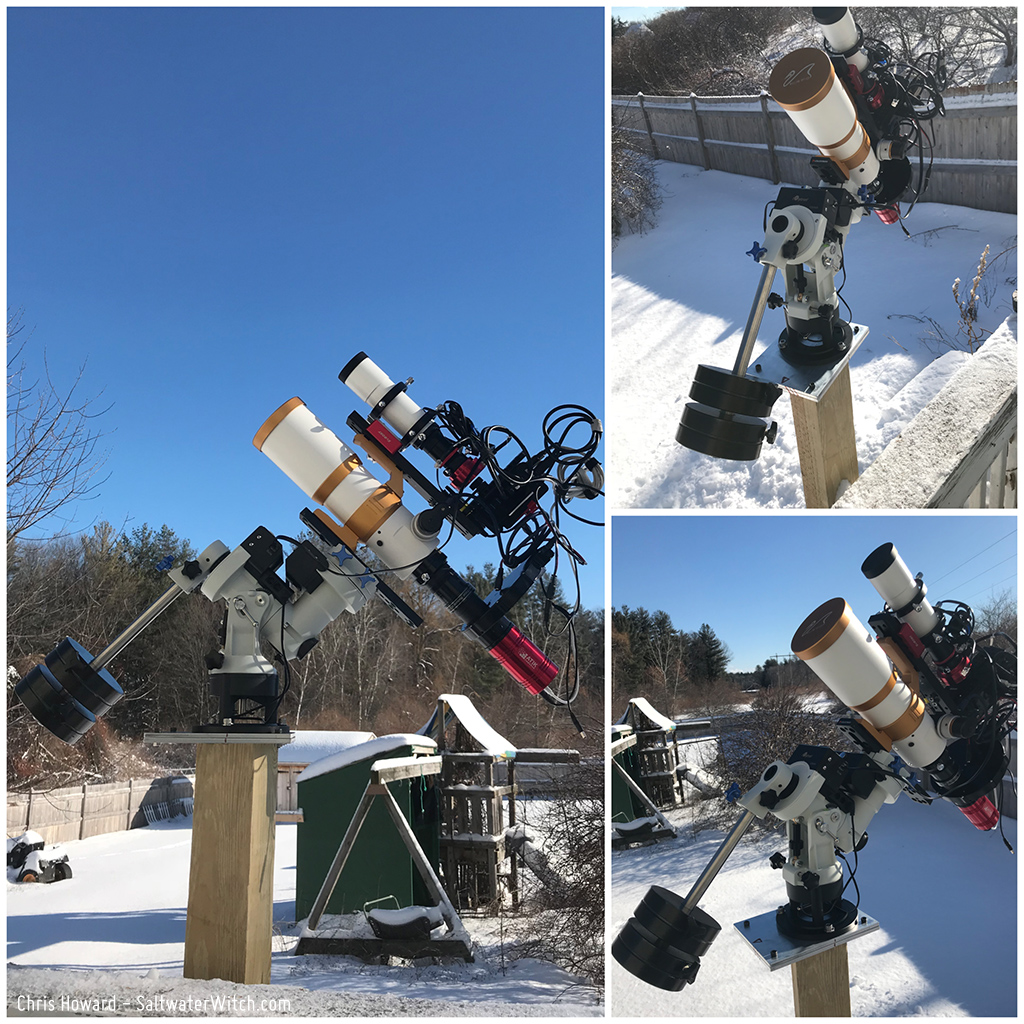Astro Session: July 9, 2018
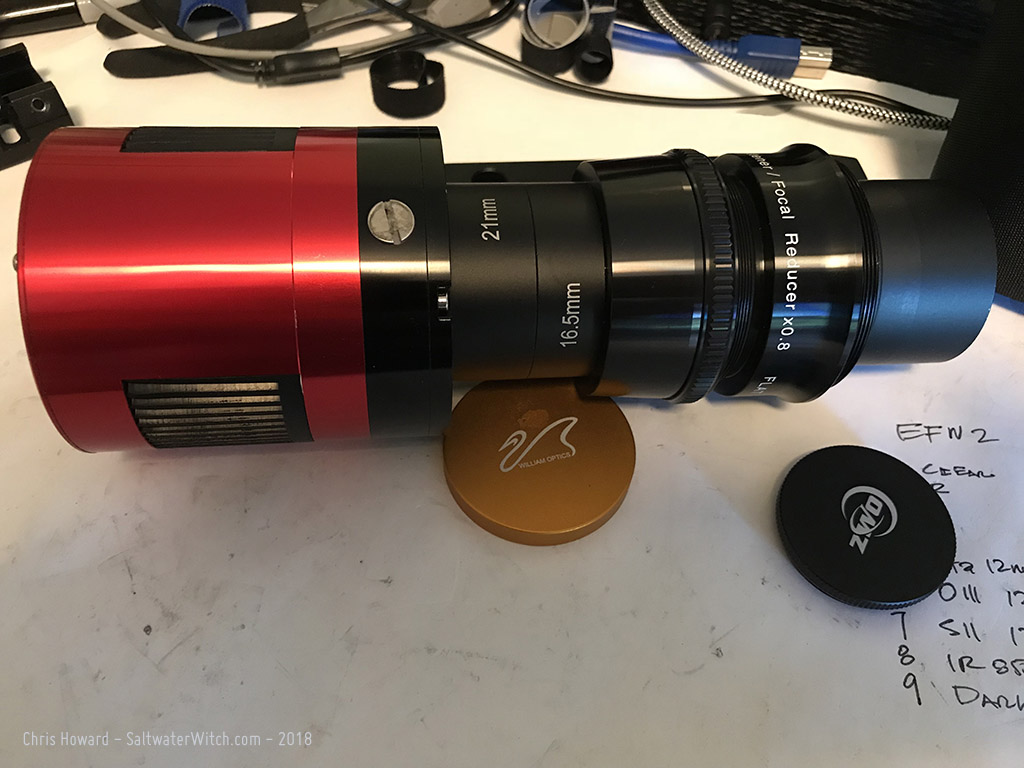 I recently bought the William Optics FLAT 6A II, and finally made it out under the stars to take some sub-exposures. I paired it with my GT-81 and ZWO ASI071MC color CMOS camera. The FLAT 6A II is a 0.8x reducer/field flattener; it's adjustable for different focal lengths, and so far, with my limited use, it appears to be quite a leap over the old William Optics F6-A I've used for a few years. The ASI071 has an APS-C sized sensor, and anyone with a large sensor astro camera or DSLR knows if you don't want field curvature with your refractor you need some sort of flattener. The FLAT6AII design makes it easy to dial in the correct distance for the scope you're using. The old reducer/flattener worked, but I had to test out a dozen different flattener to sensor distances, and still had to do some cropping and processing to fix the corners. This new FLAT 6AII provides a fairly flat field across the entire view. Equipment: William Optics GT-81 + FLAT 6A II 0.8x reducer f/4.7, ZWO ASI071MC-Cool color CMOS camera - gain 0 offset 8, ZWO ASI120MM-S Guide Cam + 130mm guide scope.
I recently bought the William Optics FLAT 6A II, and finally made it out under the stars to take some sub-exposures. I paired it with my GT-81 and ZWO ASI071MC color CMOS camera. The FLAT 6A II is a 0.8x reducer/field flattener; it's adjustable for different focal lengths, and so far, with my limited use, it appears to be quite a leap over the old William Optics F6-A I've used for a few years. The ASI071 has an APS-C sized sensor, and anyone with a large sensor astro camera or DSLR knows if you don't want field curvature with your refractor you need some sort of flattener. The FLAT6AII design makes it easy to dial in the correct distance for the scope you're using. The old reducer/flattener worked, but I had to test out a dozen different flattener to sensor distances, and still had to do some cropping and processing to fix the corners. This new FLAT 6AII provides a fairly flat field across the entire view. Equipment: William Optics GT-81 + FLAT 6A II 0.8x reducer f/4.7, ZWO ASI071MC-Cool color CMOS camera - gain 0 offset 8, ZWO ASI120MM-S Guide Cam + 130mm guide scope.
 Testing:
Testing:
With the GT81 and ASI071 I get a 3.54° x 2.35° field of view, and I can capture some big chunks of the night sky. Here are three from the last two nights: [1] the Pelican Nebula (IC 5070) and the edge of the North America Nebula (NGC7000) at the bottom, [2] IC 1396 nebula with the Elephant's Trunk at the top and the Garnet Star bottom left, and [3] M31, our galactic neighbor, the Andromeda Galaxy.
Pelican Nebula image info: ZWOASI071MC 39 x 240 second color subs stacked in DSS, processed in PSCC2018
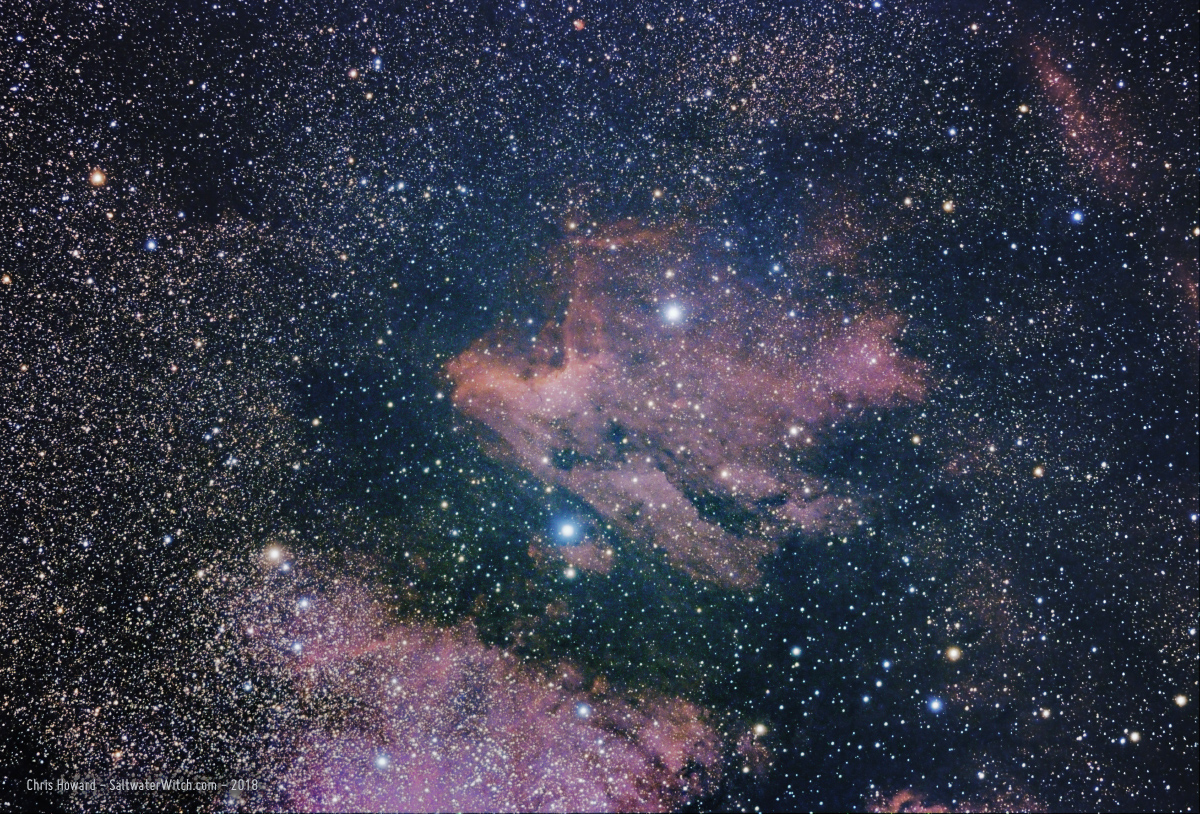
IC 1396 region image info: ZWOASI071MC 21 x 300 second color subs stacked in DSS, processed in PSCC2018
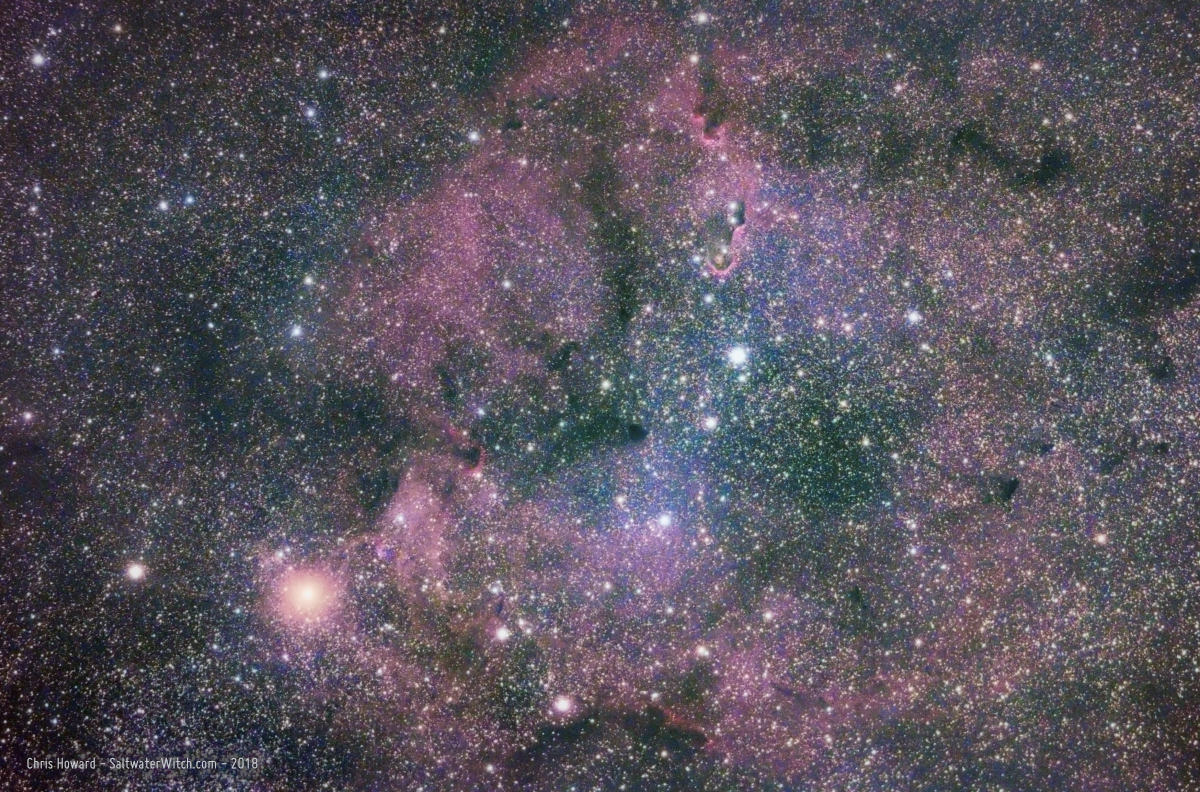
The Andromeda Galaxy. The last time I photographed Andromeda (M31) was 2015, maybe fall of 2014? It's been a while. I was using a DSLR--that was the only camera I had, and I had it on a terribly-used Celestron CG-5 equatorial mount with some aftermarket RA/DEC motors. By "terribly-used" I mean you could drive a truck through the gear backlash. Even so, I still managed to get some decent 30-second exposures of Andromeda, Orion Nebula, and other big bright targets in the sky. Well, I'm back with our galactic neighbor, and with much better gear: 192 x 120-second sub-exposures stacked in DSS, processed in PSCC2018, ZWO ASI071MC camera at -10C, William Optics GT81 APO, iOptron CEM25P EQ mount.
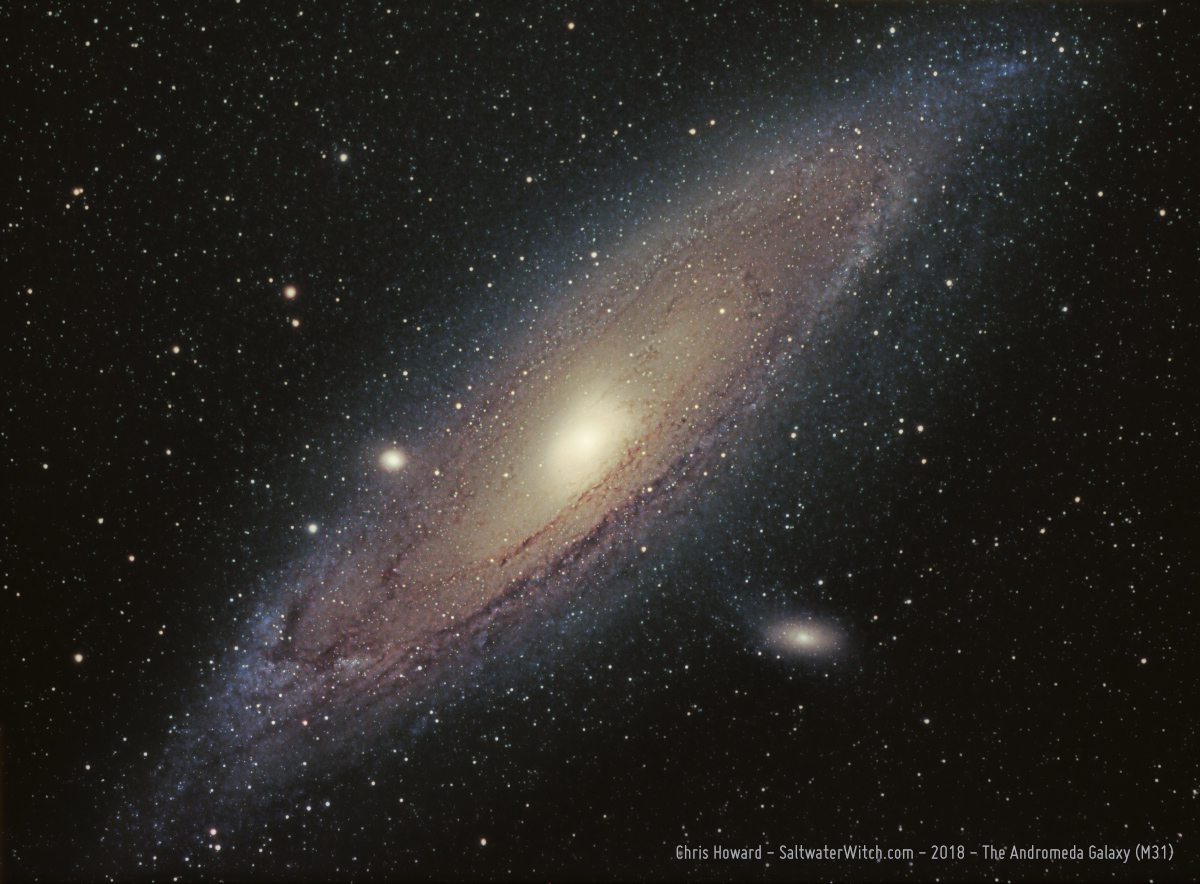
Posted July 9, 2018
Astro Session: June 8, 2018
 How about a little Voldemort with your Astronomy? Here's Barnard 104, the Fish Hook Nebula (backward checkmark nebula was already taken?), just left of the star beta Scuti in the constellation Scutum--along with several other absorption nebulae in the Barnard Catalogue, 113, 111, 110, 107, and B106. (See the image below). These are the dark cloudy regions across the middle, which stand out against the glow of a billion stars in this area of the Milky Way Galaxy. (Okay, I'm being a bit deceptive with the drama there. It's probably more like 5 or 10 billion). Oh, and let's not forget NGC 6704, the open star cluster toward the bottom in the center. A note on the "Barnard Catalogue", which is what I've always called it: I just found out the official name for it is the very Harry Potter sounding, Barnard Catalogue of Dark Markings in the Sky. Go home, Death Eaters! The star gazing geeks got here first! (ZWO ASI071MC cooled CMOS camera at -10°C, iOptron CEM25P EQ mount, William Optics ZenithStar 61 f/5.9, 12 x 120 sec. sub exposures, stacked in DSS. Location: Stratham, New Hampshire, US. Bortle 4).
How about a little Voldemort with your Astronomy? Here's Barnard 104, the Fish Hook Nebula (backward checkmark nebula was already taken?), just left of the star beta Scuti in the constellation Scutum--along with several other absorption nebulae in the Barnard Catalogue, 113, 111, 110, 107, and B106. (See the image below). These are the dark cloudy regions across the middle, which stand out against the glow of a billion stars in this area of the Milky Way Galaxy. (Okay, I'm being a bit deceptive with the drama there. It's probably more like 5 or 10 billion). Oh, and let's not forget NGC 6704, the open star cluster toward the bottom in the center. A note on the "Barnard Catalogue", which is what I've always called it: I just found out the official name for it is the very Harry Potter sounding, Barnard Catalogue of Dark Markings in the Sky. Go home, Death Eaters! The star gazing geeks got here first! (ZWO ASI071MC cooled CMOS camera at -10°C, iOptron CEM25P EQ mount, William Optics ZenithStar 61 f/5.9, 12 x 120 sec. sub exposures, stacked in DSS. Location: Stratham, New Hampshire, US. Bortle 4).

So, all in all, a successful night of astronomy stuff, even with the clouds rolling in around 2 am. Here are a couple more wide-field shots from the session, the Eagle Nebula and the Sadr Region--the diffuse nebula (IC 1318) around gamma Cygni, also called Sadr (center star in the constellation Cygnus).


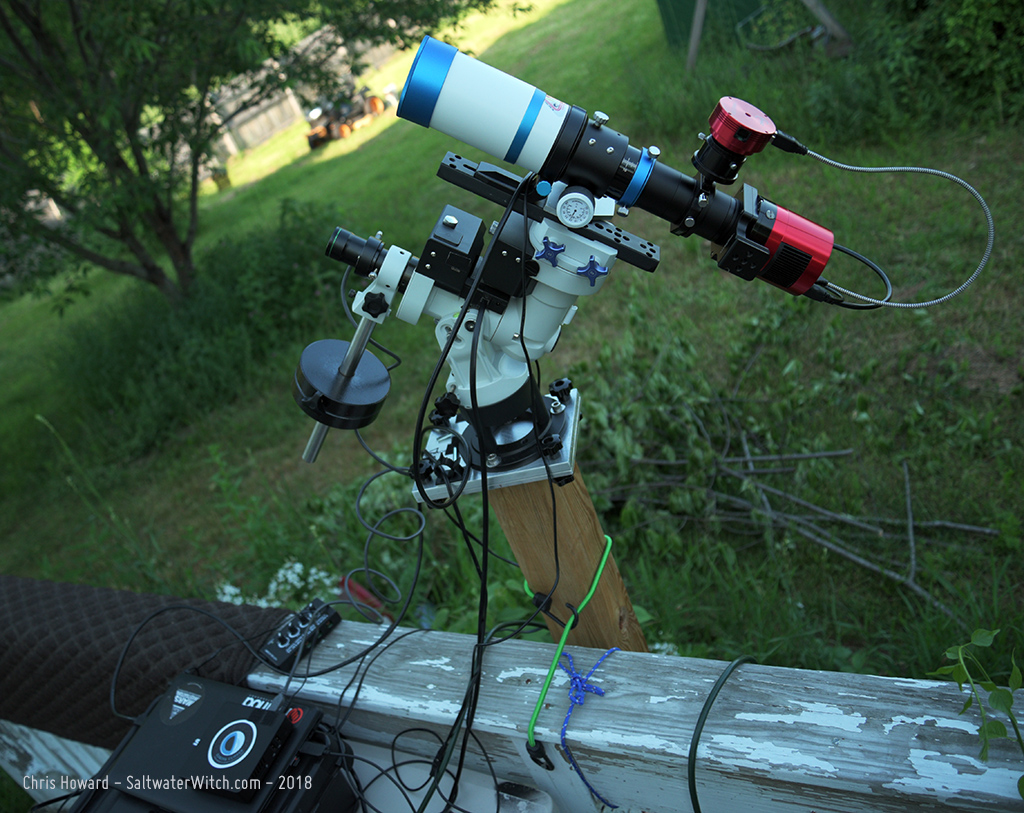 I spent a few hours last night dialing in the Orion "TOAG" or Thin Off-Axis Guider, which I bought a couple years ago, but have never been able to get working properly. I've tried seven or eight times, added it to my imaging train a couple times a year, attempting to get things working without success. Well, I went at it again last night, and you know what? It came together. I still have some weirdness to tinker with--to work out, but for the first time I wasn't guiding with a separate scope. I was guiding at the same focal length as the ZS61 using a pick-off prism that directs a portion of the field of view up into the guide camera. Here's the setup I used last night to dial-in the distance between the primary camera and guide camera, and then bring everything into focus. I ended up with some pretty cool shots, but my main purpose was to get Off-Axis Guiding (OAG) adjusted and working--and that was with me slewing around the sky to clear areas between banks of clouds to find some halfway interesting targets. In this setup I'm using my trusty ZWO ASI120MM-S for guiding, and the ZWO ASI071MC cooled color camera for the primary. The goal here is to be able to guide (track the motion of the earth against the star field to a very fine degree, and make small incremental adjustments to the EQ mount) so that I can take long exposures without worrying about the external guidescope issues I know all of you care deeply about, like field rotation and differential motion between a guide scope and imaging telescope. I have been able to take 20 minute exposures with a guidescope and camera, but the stars are not as sharp as I would like--think pressing down the button of your camera and holding the shutter open for 20 or 30 minutes and have everything in the field of view remain in sharp focus. That's essentially what the guiding system accomplishes, taking continuous images of the stars and feeding them to some pretty sophisticated software that controls the motion of the equatorial mount (that's the white z-shaped device with the black boxes on which the telescope is fastened and balanced).
I spent a few hours last night dialing in the Orion "TOAG" or Thin Off-Axis Guider, which I bought a couple years ago, but have never been able to get working properly. I've tried seven or eight times, added it to my imaging train a couple times a year, attempting to get things working without success. Well, I went at it again last night, and you know what? It came together. I still have some weirdness to tinker with--to work out, but for the first time I wasn't guiding with a separate scope. I was guiding at the same focal length as the ZS61 using a pick-off prism that directs a portion of the field of view up into the guide camera. Here's the setup I used last night to dial-in the distance between the primary camera and guide camera, and then bring everything into focus. I ended up with some pretty cool shots, but my main purpose was to get Off-Axis Guiding (OAG) adjusted and working--and that was with me slewing around the sky to clear areas between banks of clouds to find some halfway interesting targets. In this setup I'm using my trusty ZWO ASI120MM-S for guiding, and the ZWO ASI071MC cooled color camera for the primary. The goal here is to be able to guide (track the motion of the earth against the star field to a very fine degree, and make small incremental adjustments to the EQ mount) so that I can take long exposures without worrying about the external guidescope issues I know all of you care deeply about, like field rotation and differential motion between a guide scope and imaging telescope. I have been able to take 20 minute exposures with a guidescope and camera, but the stars are not as sharp as I would like--think pressing down the button of your camera and holding the shutter open for 20 or 30 minutes and have everything in the field of view remain in sharp focus. That's essentially what the guiding system accomplishes, taking continuous images of the stars and feeding them to some pretty sophisticated software that controls the motion of the equatorial mount (that's the white z-shaped device with the black boxes on which the telescope is fastened and balanced).
Posted June 8, 2018
Astro Session - March 16, 2018
 This was the first chance I've had to put the ZWO ASI071MC through some serious long exposure tests on four very different targets, the region around Alnitak in Orion, the Rosette Nebula, Markarian's Chain, and M101. I ran most of these frames with unity gain (90 Gain, 20 Offset), and I built up a nice library of dark calibration frames in the afternoon, for 600, 300, and 120 second exposure times.
This was the first chance I've had to put the ZWO ASI071MC through some serious long exposure tests on four very different targets, the region around Alnitak in Orion, the Rosette Nebula, Markarian's Chain, and M101. I ran most of these frames with unity gain (90 Gain, 20 Offset), and I built up a nice library of dark calibration frames in the afternoon, for 600, 300, and 120 second exposure times.
Rosette Nebular Region - Caldwell 49 (13 x 300 sec frames, 24 dark calibration frames) in the constellation Monoceros, about 5000 lightyears from earth. William Optics GT81 APO refractor, ZWO ASI071MC-C camera, iOptron CEM25P EQ mount.
A whole string of galaxies millions of lightyears from earth. Markarian's Chain in the Virgo Cluster, including M84, M86, the Eyes Galaxies (NGC 4435 and NGC 4438) and a few more galaxies and galaxy pairs. The Eyes are 52 million lightyears away! 30 x 120 sec frames, 20 dark frames, stacked in DSS. William Optics GT81 APO refractor, ZWO ASI071MC-C camera, iOptron CEM25P EQ mount.

Pinwheel Galaxy, M101, a spiral galaxy about 21 million lightyears from earth in the constellation Ursa Major (Big Dipper). (Light frames: 10 x 120 secs, 4 x 600 secs, 12 x 300 secs). William Optics GT81 APO refractor, ZWO ASI071MC-C camera, iOptron CEM25P EQ mount, INDI/KStars/Ekos.


Part of the Orion Molecular Cloud Complex that surrounds the blue supergiant Alnitak (large star in the center), including the Flame Nebula (NGC 2024), IC 434, Horsehead Nebula (Barnard 33), NGC 2023, IC 431, and more. About 1500 lightyears from earth. (22 x 300 sec frames, 24 dark frames). William Optics GT81 APO refractor, ZWO ASI071MC-C camera, iOptron CEM25P EQ mount. In case you're wondering, I'm pretty damned excited about this camera (ZWO ASI071MC), just going off what it can capture in faint nebulosity, and what I can bring out without much effort by stretching 22 stacked frames. I can't wait to see what I can capture in the summer when the big galaxies like Andromeda and Triangulum swing through.

Here's my setup for last night's astro session, with the William Optics GT81 APO refractor, ZWO ASI071MC-C primary camera, iOptron CEM25P EQ mount.

Posted March 16, 2018
Astro gear - December 25, 2017
My Winter Astro Setup, essentially the same William Optics GT-81 - iOptron CEM25 combo, with the addition of the iOptron Tri-Pier Adapter, some 6x8 aluminum plates off eBay, and one treated 4x4 post from Home Depot.
The good side of winter and astrophotography is it’s usually dry on clear nights--and “clear” really means clear in terms of astronomical seeing, atmospheric turbulence and all that. Downside is that it’s freakin’ cold. Tonight it’s supposed to get down to about -8°C (about 20°F), pretty cold to be out for a long time, but not painfully cold.
Here are a couple shots of my setup for tonight--and possibly the rest of the winter. (William Optics GT-81, CEM25P EQ mount, Atik414Ex mono CCD, WO 50mm guidescope with ZWO ASI120S-MM guide cam, INDI/KStars/Ekos observatory control). What’s cool is that I can unbolt the mount with the pier adapter and aluminum base plate (they’re all bolted together) from the 4x4 post and top plate, and carry in the entire setup--mount, scope, cameras, etc. What I especially like about this is the ease with which I can setup and tear down each night. The whole thing remains balanced and ready to go, with polar alignment reduced to very fine adjustment to zero in on the NCP.
Note on my other mount: I probably won’t use my Orion Atlas EQ-G mount until spring when things start to warm up, and that’s based on the weight of the Atlas and the low temperatures--with ice adding some difficulty to the setup process. (Yeah, I don’t want to lug around this monster with any probability of slipping, landing on my back, and having to catch fifty or sixty pounds of metal out of the air before it kills someone). The average winter low in New Hampshire is around -12°C, and the average winter high temp is still below 0°C (around 30°F). It’s not unusual for things to get down to -20 to -30°C (-10 to -20°F). We’re still in December, so early in the season, but we’re already getting repeated snow storms interspersed with temps above 0°C (32°F). We typically get a few days of warmer weather here and there, snow and ice melting weather, but there haven’t been enough of them to make a dent in the accumulating snow and ice we have in the yard, driveway, or back deck. We just ended yesterday (the 25th) with another 6 inches or so. When there’s ice, lighter is better.

